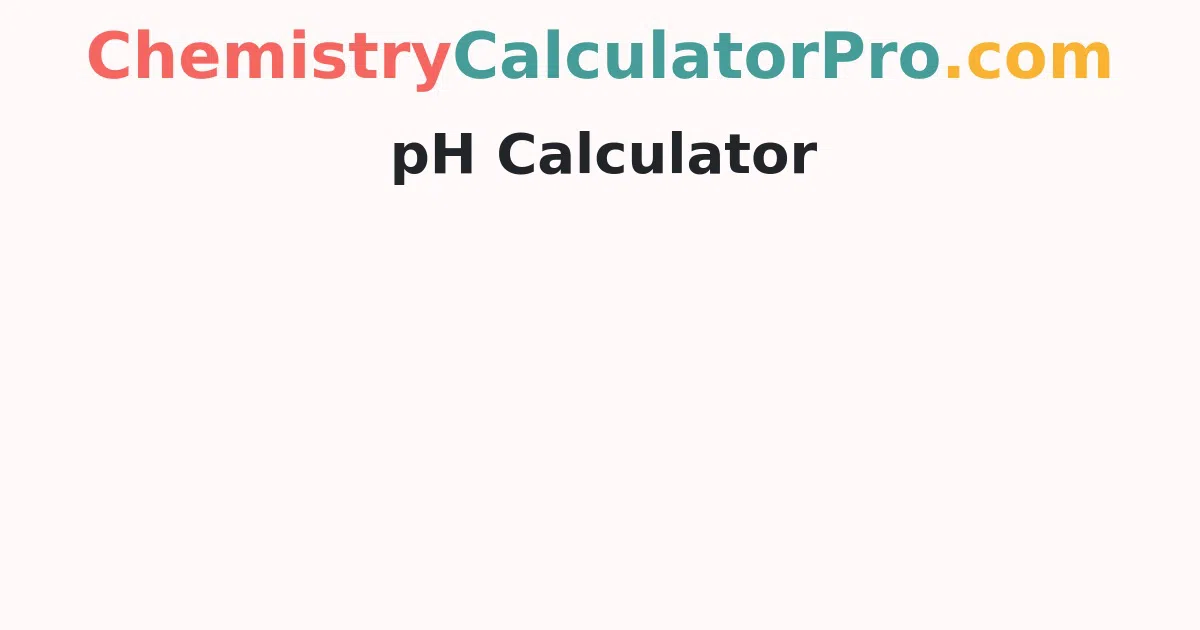pH Calculator
To get pH value as output, you need to give Input i.e Concentration and select dropdown molars/millimolars/micro molars and click on calculate to get pH value as output. Concentration value should be less than 1. Ex. 0.005, 0.3, 0.0076 etc.
Ex: 0.03, 0.45, 0.34 or 0.0034
pH Formula
pH= -log[H+]
p>
pH stand for potential of hydrogen
[H+] is the concentration of hydrogen ions in the solution.
Brackets [ ] refers to Molarity(M).
Units of Molarity is moles per liter of solution.
pOH = -log[OH-]
[OH-] is concentration of hydroxy ions in the solution. No units for pH
Relation between pH and pOH
pH + pOH = 14
Range of pH: The range goes from 0 to 14, with 7 being NEUTRAL. pHs of less than 7 indicate ACID , whereas a pH of greater than 7 indicates BASE.
Guidelines to Measure pH
Follow the simple steps listed below to measure pH. They are as such
- Get concentration of hydrogen ions in solution
- Calculate pH by using formula by substituting H+ concentration
- We can also find pOH by subtracting 14 minus pH value.
How is pH Measured?
There are different methods for measuring the pH and they are as follows
- Colorimetric method
- Using indicator solutions or papers
- Electrochemical method
- Using electrodes and a Mill voltmeter (pH meter)
Importance of pH Testing in Everyday Life
In the human body, all the physiological reactions take place in the pH of 7- 7.8. pH is very important in our digestive system. In the stomach, hydrochloric acid is secreted as food enters the stomach. It turns the pH of the stomach between 1 and 3.This pH is important for the activation of the enzyme pepsin, which helps in the digestion of protein in food.
When the pH of the mouth falls below 5.5 our tooth starts decaying. Tooth powder and toothpaste which are used for cleaning teeth are basic in nature. Living organisms can survive only in a narrow range of pH change. When pH of rain-water is less than 5.6. It is called Acid rain.
The pH can control the availability of nutrients, biological functions, microbial activity, and the behavior of chemicals. Because of this, monitoring or controlling the pH of the soil, water, and food or beverage products is important for a wide variety of applications.
pH Indicators
Synthetic Indicators: Indicators that are synthesized in laboratory are known as synthetic indicators. Ex: phenolphthalein, methyl orange, etc.
Natural Indicators: Indicators obtained from natural sources are called “Natural indicators”. one of the most well-known effects of natural indicators in plants occurs in the hydrangea or snowball plant. Hydrangea flowers are blue when grown in acidic soils and pink or red in basic soils. Other common examples of natural indicators include turmeric, beetroot juice etc.
Examples on Calculating pH Value
Example 1.
Find the pH of a 0.0025M HCl solution?
Solution:
Given that Hydronium concentration is 0.0025M
To calculate the pH of 0.0025M Hydrochloric acid solution takes the negative logarithm of hydronium ion concentration.
pH = -log([H+])
Substitute Concentration value in [ H+] i.e. 0.0025 in formula
Given that, H+ =0.0025M
= -log(0.0025)
= -(-2.60)
= 2.60
pH of HCl Solution is 2.60 so it is acidic in nature
If value is less than 7 it is Acidic in nature, greater than 7 it is Basic in nature, equal to 7 it is Neutral in nature.
Example 2.
Given a pH of 2.38, find the concentration of H+ in the solution?
Solution:
Given that pH is 2.38
To calculate concentration of H= take negative logarithm of hydronium ions concentration.
Here we need to calculate H+ where pH = -log([H+])
Multiply both sides with minus and perform mathematical operations.
2.38= -log([H+])
-2.38= log([H+])
10-2.38= [H+]
4.17*10-3 = [ H+]
Concentration of [ H+ ]ions is = 4.17*10-3
If value is less than 7 it is Acidic in nature, greater than 7 it is Basic in nature, equal to 7 it is Neutral in nature.
FAQ’s on pH Calculator
1. What is meant by pH Scale?
Scale to measure hydrogen ions[ h+] concentration ranges from 0 to 14.
2. What is meant by pH and its Formula?
pH is to measure concentration of hydrogen ions[H+] present in the solution pH = -log([H+])
3. What is pH Abbreviation?
pH stands for “POTENTIAL OF HYDROGEN” or “POWER OF HYDROGEN”.
4. How to calculate pOH?
We can find pOH by subtracting pH from 14 i.e. pOH = 14 - pH
